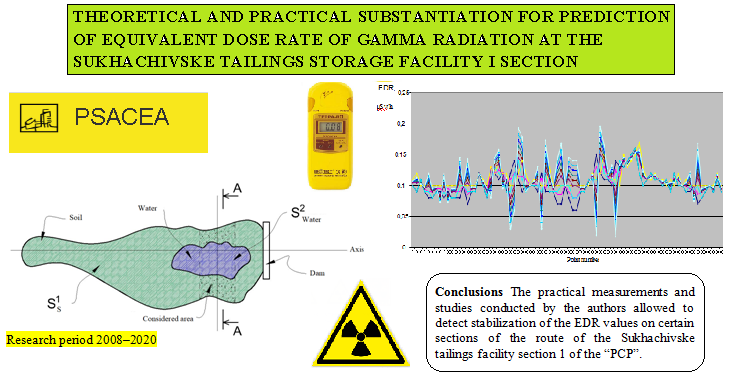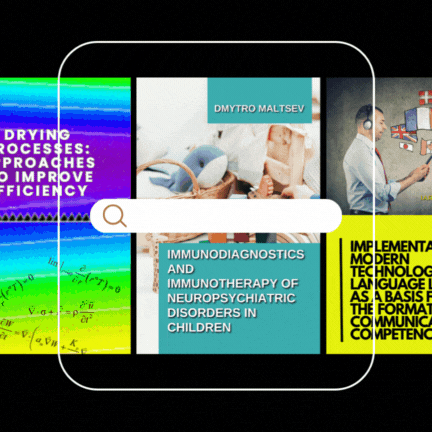Theoretical and practical substantiation for prediction of equivalent dose rate of gamma radiation at the Sukhachivske tailings storage facility I section
DOI:
https://doi.org/10.15587/2706-5448.2024.319636Keywords:
measurement of parameters, tailings facility, radiation facility, radiation monitoring, γ-radiation, absorbed and exposure dose ratesAbstract
The object of the study is the Sukhachivske industrial site, tailings storage facility section I (Ukraine). The main reason for conducting the study is to establish actual and forecast numerical values of absorbed and exposure dose rates. The state of radiation contamination of the tailing’s storage facilities of the Sukhachivske industrial site was analyzed. The actual and prolonged levels of equivalent dose rate, absorbed dose rate, and total personnel exposure dose were determined. Dependencies were established that allow determining approximate numerical values for specific conditions and certain areas using the finite element method with subsequent transfer of values to 2024–2027. Based on the conducted studies, the dynamics of contamination at the Sukhachivske tailings storage facility section I was predicted. The estimated, forecast, and actual values of personnel exposure doses were determined for the period from 2010 to 2023. New methods and algorithms for instrumental measurement of radiation parameters at the tailing’s facilities of the former uranium production facility of the Prydniprovsky Chemical Plant have been developed. The state of radiation contamination of the tailing’s facilities of the Sukhachivke industrial site has been analyzed. The actual and prolonged levels of equivalent dose rate, absorbed dose rate, total personnel exposure dose, and contamination levels of the territories adjacent to the tailings facilities have been determined. Monitoring studies over ten years have allowed to determine the actual values of the exposure dose rate, which range from 0.08 to 0.21 μSv/h with certain local values up to 0.26 μSv/h. In general, the total personnel exposure dose does not exceed 1.1–1.4 mSv/year. The obtained data on prognostic values, in turn, make it possible to predict the further radiation situation at the Sukhachivske industrial site in the coming years. As well as to improve the system for calculating the total effective radiation dose, both to the personnel of the radiation-hazardous facility and to the population living near the industrial site.
Supporting Agency
- This article is a logical continuation of the scientific developments of the Department of Labor Protection, Civil and Technogenic Safety of the Ukrainian State University of Science and Technology, NSI “Prydniprovska State Academy of Civil Engineering and Architecture”. The current scientific and research work is carried out according to the departmental theme “Occupational Protection, Industrial, Civil and Environmental Safety in Various Spheres of Human Life” No. State Registration 0124U001896 (in the period 2024–2026). This issue is of great importance for both the Dnipropetrovsk region and the state of Ukraine. There are about 42 million tons of solid and liquid radioactive waste from former uranium production at industrial sites.
References
- Coulibaly, A., Kpeglo, D. O., Darko, E. O. (2023). Assessment of Radiological Hazards in Some Foods Products Consumed by the Malian Population Using Gamma Spectrometry. Journal of Radiation Protection and Research, 48 (2), 84–89. https://doi.org/10.14407/jrpr.2022.00178
- Nkoulou, J. E. N., Engola, L. N., Dallou, G. B., Saïdou, Bongue, D., Hosoda, M. et al. (2023). Public Exposure to Natural Radiation and the Associated Increased Risk of Lung Cancer in the Betare-Oya Gold Mining Areas, Eastern Cameroon. Journal of Radiation Protection and Research, 48 (2), 59–67. https://doi.org/10.14407/jrpr.2021.00388
- Ghazal, A. A., Alakash, R., Aljumaili, Z., El-Sayed, A., Abdel-Rahman, H. (2023). Enhancing Gamma-Neutron Shielding Effectiveness of Polyvinylidene Fluoride for Potent Applications in Nuclear Industries: A Study on the Impact of Tungsten Carbide, Trioxide, and Disulfide Using EpiXS, Phy-X/PSD, and MCNP5 Code. Journal of Radiation Protection and Research, 48 (4), 184–196. https://doi.org/10.14407/jrpr.2023.00213
- Lee, C. (2024). A Review of Organ Dose Calculation Methods and Tools for Patients Undergoing Diagnostic Nuclear Medicine Procedures. Journal of Radiation Protection and Research, 49 (1), 1–18. https://doi.org/10.14407/jrpr.2023.00087
- Lee, Y., Choi, J. W., Braunstein, L., Lee, C., Yeom, Y. S. (2024). Investigation on Individual Variation of Organ Doses for Photon External Exposures: A Monte Carlo Simulation Study. Journal of Radiation Protection and Research, 49 (1), 50–64. https://doi.org/10.14407/jrpr.2023.00661
- Poorbaygi, H., Salimi, S. M., Torkzadeh, F., Hamidi, S., Sheibani, S. (2023). Determination of Exposure during Handling of 125I Seed Using Thermoluminescent Dosimeter and Monte Carlo Method Based on Computational Phantom. Journal of Radiation Protection and Research, 48 (4), 197–203. https://doi.org/10.14407/jrpr.2023.00255
- Nizam, Q. M. R., Ahmed, A., Ahmed, I. (2023). Monte Carlo Calculation for Production Cross-Sections of Projectile’s Isotopes from Therapeutic Carbon and Helium Ion Beams in Different Materials. Journal of Radiation Protection and Research, 48 (4), 204–212. https://doi.org/10.14407/jrpr.2023.00262
- Pylypenko, O., Shalomov, V., Strezhekurov, Y., Rudenko, V., Tymchenko, P. (2024). The effect of external radiation exposure per person depending on his position and anthropometric indicators. E3S Web of Conferences, 534, 01016. https://doi.org/10.1051/e3sconf/202453401016
- Bernhardsson, C. (2014). Experimental determination of dose conversion coefficients for external radiation exposure with gamma emitting radionuclides. Radiatsionnaya Gygiena, 7 (4), 125–133. Available at: https://lup.lub.lu.se/record/5048649
- Sasaki, M., Furukawa, K., Satoh, D., Shimada, K., Kudo, S., Takagi, S. et al. (2023). SUMRAY: R and Python Codes for Calculating Cancer Risk Due to Radiation Exposure of a Population. Journal of Radiation Protection and Research, 48 (2), 90–99. https://doi.org/10.14407/jrpr.2022.00213
- Deiaki pytannia identyfikatsii obiektiv pidvyshchenoi nebezpeky (2022). Postanova KMU No. 1030. 13.09.2022. Available at: https://www.kmu.gov.ua/npas/deiaki-pytannia-identyfikatsii-obiektiv-1030
- Deiaki pytannia obiektiv krytychnoi infrastruktury (2024). Postanova KMU No. 1109. 09.10.2020. Available at: https://zakon.rada.gov.ua/laws/show/1109-2020-%D0%BF#Text
- ICRP, 1991. 1990 Recommendations of the International Commission on Radiological Protection. ICRP Publication 60. Ann. ICRP 21 (1–3) (1991). ICRP. Available at: https://www.icrp.org/publication.asp?id=icrp%20publication%2060
- ICRP, 2007. The 2007 Recommendations of the International Commission on Radiological Protection. ICRP Publication 103. Ann. ICRP 37 (2–4) (2007). ICRP. Available at: https://www.icrp.org/publication.asp?id=ICRP%20Publication%20103
- ICRP, 2022. Occupational Intakes of Radionuclides: Part 5. ICRP Publication 151. Ann. ICRP 51 (1–2) (2022). ICRP. Available at: https://www.icrp.org/publication.asp?id=ICRP%20Publication%20151
- Trubey, D. K., Harima, Y. (1986). New Buildup Factor Data for Point Kernel Calculations. Technical Report. Oak Ridge National Lab. Available at: https://www.osti.gov/servlets/purl/6401756
- Little, A., Piggott, M. D., Buchan, A. G. (2022). Development of a gamma ray dose rate calculation and mapping tool for Lagrangian marine nuclear emergency response models. Marine Pollution Bulletin, 181, 113895. https://doi.org/10.1016/j.marpolbul.2022.113895
- ICRP, 2022. Radiation detriment calculation methodology. ICRP Publication 152. Ann. ICRP 51(3) (2022). ICRP. Available at: https://www.icrp.org/publication.asp?id=ICRP%20Publication%20152

Downloads
Published
How to Cite
Issue
Section
License
Copyright (c) 2024 Volodymyr Korotaiev, Anatolii Bielikov, Oleksandr Pylypenko, Serhii Podkopaiev, Oleksandr Tkachuk, Volodymyr Shalomov

This work is licensed under a Creative Commons Attribution 4.0 International License.
The consolidation and conditions for the transfer of copyright (identification of authorship) is carried out in the License Agreement. In particular, the authors reserve the right to the authorship of their manuscript and transfer the first publication of this work to the journal under the terms of the Creative Commons CC BY license. At the same time, they have the right to conclude on their own additional agreements concerning the non-exclusive distribution of the work in the form in which it was published by this journal, but provided that the link to the first publication of the article in this journal is preserved.







